#online data entry software
Explore tagged Tumblr posts
Text
Data Editar Form Filling Auto Typing Software
Data Editar Form Filling Auto Typing Software, Form Filling Auto Typer is the best accurate Software.How to Auto Type Covid data entry work, We have solution for Covid data form filling auto typing. Data Editar Form Filling Auto Typing Software Vedio https://youtu.be/DS2TtWXH4Kw We are introducing Data Editar Covid Bill Updation form filling auto typing software Process of auto typing.1)RVS Team…
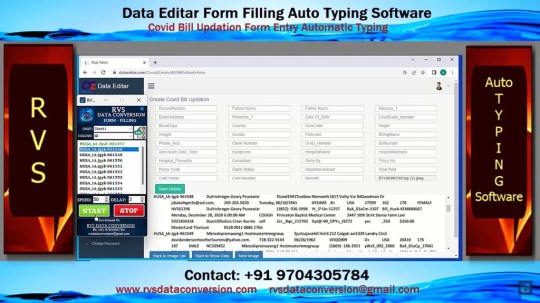
View On WordPress
#Covid bill updation auto typer#Covid Data Editar auto typer#Covid Data editar auto typing software#Data editar form filling auto typer#Data Editar Form Filling Auto Typing Software#data entry auto typing software#Data entry Jobs#Form Filling Auto Typer#form filling data entry auto typing tool#How To auto fill Data Editar form filling project#Medical form filling auto typing software#online data editar form filling auto typing
0 notes
Text
Elevating Excellence: Why the Transportation and Logistics Industry Should Prioritize Enhanced Customer Service
In the fast-paced and competitive realm of transportation and logistics, the emphasis on enhanced customer service is becoming increasingly vital. This blog post delves into the reasons why the transportation and logistics industry should prioritize customer service, exploring how it can lead to increased customer satisfaction, improved operational efficiency, and a strengthened market position.
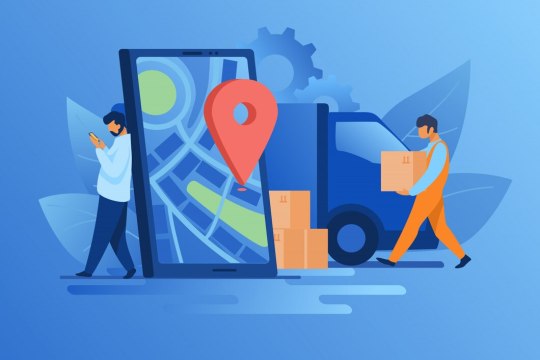
Transportation Customer Service:
Transportation customer service underscores the unique challenges and opportunities within the transportation sector. Acknowledging the specific needs of customers in the logistics chain is crucial for building lasting relationships and ensuring a positive overall experience.
Customer Support Management:
The customer support management highlights the strategic approach required to deliver exceptional customer service. Effective management of customer support processes, from order inquiries to issue resolution, is instrumental in meeting and exceeding customer expectations.
Multilingual Customer Support:
In an increasingly globalized world, the term Multilingual customer support becomes pivotal. Offering customer support in multiple languages is not just a convenience; it is a necessity in a diverse and interconnected marketplace. Multilingual customer support enhances accessibility, fosters international collaboration, and demonstrates a commitment to meeting the unique needs of a global customer base.
Reasons to Prioritize Enhanced Customer Service:
Customer Satisfaction: A focus on enhanced customer service directly correlates with increased customer satisfaction. By providing prompt and accurate information, addressing concerns proactively, and ensuring a seamless experience, businesses build trust and loyalty among their clientele.
Operational Efficiency: Streamlining customer support management contributes to operational efficiency. Resolving issues promptly, minimizing order discrepancies, and optimizing communication channels lead to smoother logistics operations and reduced disruptions.
Competitive Edge: In an industry where competition is fierce, superior customer service becomes a key differentiator. Companies that prioritize customer satisfaction gain a competitive edge, attracting and retaining clients in a market where service quality often defines success.
Brand Reputation: Customer service plays a crucial role in shaping a brand's reputation. Positive interactions with customers contribute to a positive brand image, while subpar customer service can lead to reputational damage. A strong brand reputation, built on excellent customer service, enhances market credibility and trust.
Conclusion: In conclusion, prioritizing enhanced customer service in the transportation and logistics industry is not just a matter of meeting expectations; it is a strategic imperative. From transportation customer service tailored to the unique needs of the industry to effective customer support management and multilingual support for a global clientele, the benefits are manifold. By placing customer satisfaction at the forefront, businesses in the transportation and logistics sector can navigate challenges, foster growth, and secure a prominent position in an ever-evolving and competitive marketplace. In a world where customer-centricity is paramount, elevating customer service becomes a pathway to sustained success and industry leadership.
#Transportation customer service#customer support management#Multilingual customer support#Trucking Dispatch Companies#Bpo services#Support center#Support ticket system#Live chat support#Online support#Customer support software#Healthcare bpo#Healthcare business process outsourcing#load board outsourcing#end to end supply chain#Data entry outsourcing#Business process outsourcing companies#Customer support outsourcing#claim managament#Bpo solutions#Customer support solutions#Customer support chat#supply chain outsourcing#Back office outsourcing#Customer support team#back office outsourcing services#carrier onboarding#logistics control tower#Offshore bpo#transporation customer service#Customer support ticket
0 notes
Text
So, let me try and put everything together here, because I really do think it needs to be talked about.
Today, Unity announced that it intends to apply a fee to use its software. Then it got worse.
For those not in the know, Unity is the most popular free to use video game development tool, offering a basic version for individuals who want to learn how to create games or create independently alongside paid versions for corporations or people who want more features. It's decent enough at this job, has issues but for the price point I can't complain, and is the idea entry point into creating in this medium, it's a very important piece of software.
But speaking of tools, the CEO is a massive one. When he was the COO of EA, he advocated for using, what out and out sounds like emotional manipulation to coerce players into microtransactions.
"A consumer gets engaged in a property, they might spend 10, 20, 30, 50 hours on the game and then when they're deep into the game they're well invested in it. We're not gouging, but we're charging and at that point in time the commitment can be pretty high."
He also called game developers who don't discuss monetization early in the planning stages of development, quote, "fucking idiots".
So that sets the stage for what might be one of the most bald-faced greediest moves I've seen from a corporation in a minute. Most at least have the sense of self-preservation to hide it.
A few hours ago, Unity posted this announcement on the official blog.
Effective January 1, 2024, we will introduce a new Unity Runtime Fee that’s based on game installs. We will also add cloud-based asset storage, Unity DevOps tools, and AI at runtime at no extra cost to Unity subscription plans this November. We are introducing a Unity Runtime Fee that is based upon each time a qualifying game is downloaded by an end user. We chose this because each time a game is downloaded, the Unity Runtime is also installed. Also we believe that an initial install-based fee allows creators to keep the ongoing financial gains from player engagement, unlike a revenue share.
Now there are a few red flags to note in this pitch immediately.
Unity is planning on charging a fee on all games which use its engine.
This is a flat fee per number of installs.
They are using an always online runtime function to determine whether a game is downloaded.
There is just so many things wrong with this that it's hard to know where to start, not helped by this FAQ which doubled down on a lot of the major issues people had.
I guess let's start with what people noticed first. Because it's using a system baked into the software itself, Unity would not be differentiating between a "purchase" and a "download". If someone uninstalls and reinstalls a game, that's two downloads. If someone gets a new computer or a new console and downloads a game already purchased from their account, that's two download. If someone pirates the game, the studio will be asked to pay for that download.
Q: How are you going to collect installs? A: We leverage our own proprietary data model. We believe it gives an accurate determination of the number of times the runtime is distributed for a given project. Q: Is software made in unity going to be calling home to unity whenever it's ran, even for enterprice licenses? A: We use a composite model for counting runtime installs that collects data from numerous sources. The Unity Runtime Fee will use data in compliance with GDPR and CCPA. The data being requested is aggregated and is being used for billing purposes. Q: If a user reinstalls/redownloads a game / changes their hardware, will that count as multiple installs? A: Yes. The creator will need to pay for all future installs. The reason is that Unity doesn’t receive end-player information, just aggregate data. Q: What's going to stop us being charged for pirated copies of our games? A: We do already have fraud detection practices in our Ads technology which is solving a similar problem, so we will leverage that know-how as a starting point. We recognize that users will have concerns about this and we will make available a process for them to submit their concerns to our fraud compliance team.
This is potentially related to a new system that will require Unity Personal developers to go online at least once every three days.
Starting in November, Unity Personal users will get a new sign-in and online user experience. Users will need to be signed into the Hub with their Unity ID and connect to the internet to use Unity. If the internet connection is lost, users can continue using Unity for up to 3 days while offline. More details to come, when this change takes effect.
It's unclear whether this requirement will be attached to any and all Unity games, though it would explain how they're theoretically able to track "the number of installs", and why the methodology for tracking these installs is so shit, as we'll discuss later.
Unity claims that it will only leverage this fee to games which surpass a certain threshold of downloads and yearly revenue.
Only games that meet the following thresholds qualify for the Unity Runtime Fee: Unity Personal and Unity Plus: Those that have made $200,000 USD or more in the last 12 months AND have at least 200,000 lifetime game installs. Unity Pro and Unity Enterprise: Those that have made $1,000,000 USD or more in the last 12 months AND have at least 1,000,000 lifetime game installs.
They don't say how they're going to collect information on a game's revenue, likely this is just to say that they're only interested in squeezing larger products (games like Genshin Impact and Honkai: Star Rail, Fate Grand Order, Among Us, and Fall Guys) and not every 2 dollar puzzle platformer that drops on Steam. But also, these larger products have the easiest time porting off of Unity and the most incentives to, meaning realistically those heaviest impacted are going to be the ones who just barely meet this threshold, most of them indie developers.
Aggro Crab Games, one of the first to properly break this story, points out that systems like the Xbox Game Pass, which is already pretty predatory towards smaller developers, will quickly inflate their "lifetime game installs" meaning even skimming the threshold of that 200k revenue, will be asked to pay a fee per install, not a percentage on said revenue.
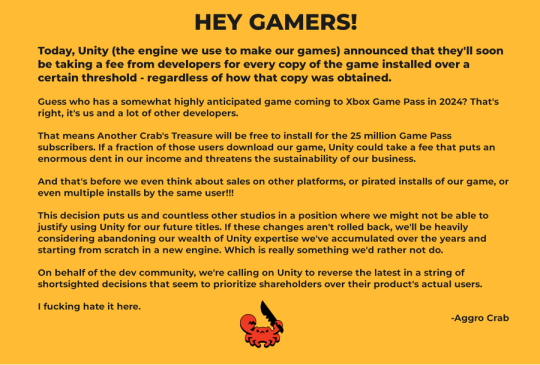
[IMAGE DESCRIPTION: Hey Gamers!
Today, Unity (the engine we use to make our games) announced that they'll soon be taking a fee from developers for every copy of the game installed over a certain threshold - regardless of how that copy was obtained.
Guess who has a somewhat highly anticipated game coming to Xbox Game Pass in 2024? That's right, it's us and a lot of other developers.
That means Another Crab's Treasure will be free to install for the 25 million Game Pass subscribers. If a fraction of those users download our game, Unity could take a fee that puts an enormous dent in our income and threatens the sustainability of our business.
And that's before we even think about sales on other platforms, or pirated installs of our game, or even multiple installs by the same user!!!
This decision puts us and countless other studios in a position where we might not be able to justify using Unity for our future titles. If these changes aren't rolled back, we'll be heavily considering abandoning our wealth of Unity expertise we've accumulated over the years and starting from scratch in a new engine. Which is really something we'd rather not do.
On behalf of the dev community, we're calling on Unity to reverse the latest in a string of shortsighted decisions that seem to prioritize shareholders over their product's actual users.
I fucking hate it here.
-Aggro Crab - END DESCRIPTION]
That fee, by the way, is a flat fee. Not a percentage, not a royalty. This means that any games made in Unity expecting any kind of success are heavily incentivized to cost as much as possible.

[IMAGE DESCRIPTION: A table listing the various fees by number of Installs over the Install Threshold vs. version of Unity used, ranging from $0.01 to $0.20 per install. END DESCRIPTION]
Basic elementary school math tells us that if a game comes out for $1.99, they will be paying, at maximum, 10% of their revenue to Unity, whereas jacking the price up to $59.99 lowers that percentage to something closer to 0.3%. Obviously any company, especially any company in financial desperation, which a sudden anchor on all your revenue is going to create, is going to choose the latter.
Furthermore, and following the trend of "fuck anyone who doesn't ask for money", Unity helpfully defines what an install is on their main site.
While I'm looking at this page as it exists now, it currently says
The installation and initialization of a game or app on an end user’s device as well as distribution via streaming is considered an “install.” Games or apps with substantially similar content may be counted as one project, with installs then aggregated to calculate the Unity Runtime Fee.
However, I saw a screenshot saying something different, and utilizing the Wayback Machine we can see that this phrasing was changed at some point in the few hours since this announcement went up. Instead, it reads:
The installation and initialization of a game or app on an end user’s device as well as distribution via streaming or web browser is considered an “install.” Games or apps with substantially similar content may be counted as one project, with installs then aggregated to calculate the Unity Runtime Fee.
Screenshot for posterity:

That would mean web browser games made in Unity would count towards this install threshold. You could legitimately drive the count up simply by continuously refreshing the page. The FAQ, again, doubles down.
Q: Does this affect WebGL and streamed games? A: Games on all platforms are eligible for the fee but will only incur costs if both the install and revenue thresholds are crossed. Installs - which involves initialization of the runtime on a client device - are counted on all platforms the same way (WebGL and streaming included).
And, what I personally consider to be the most suspect claim in this entire debacle, they claim that "lifetime installs" includes installs prior to this change going into effect.
Will this fee apply to games using Unity Runtime that are already on the market on January 1, 2024? Yes, the fee applies to eligible games currently in market that continue to distribute the runtime. We look at a game's lifetime installs to determine eligibility for the runtime fee. Then we bill the runtime fee based on all new installs that occur after January 1, 2024.
Again, again, doubled down in the FAQ.
Q: Are these fees going to apply to games which have been out for years already? If you met the threshold 2 years ago, you'll start owing for any installs monthly from January, no? (in theory). It says they'll use previous installs to determine threshold eligibility & then you'll start owing them for the new ones. A: Yes, assuming the game is eligible and distributing the Unity Runtime then runtime fees will apply. We look at a game's lifetime installs to determine eligibility for the runtime fee. Then we bill the runtime fee based on all new installs that occur after January 1, 2024.
That would involve billing companies for using their software before telling them of the existence of a bill. Holding their actions to a contract that they performed before the contract existed!
Okay. I think that's everything. So far.
There is one thing that I want to mention before ending this post, unfortunately it's a little conspiratorial, but it's so hard to believe that anyone genuinely thought this was a good idea that it's stuck in my brain as a significant possibility.
A few days ago it was reported that Unity's CEO sold 2,000 shares of his own company.
On September 6, 2023, John Riccitiello, President and CEO of Unity Software Inc (NYSE:U), sold 2,000 shares of the company. This move is part of a larger trend for the insider, who over the past year has sold a total of 50,610 shares and purchased none.
I would not be surprised if this decision gets reversed tomorrow, that it was literally only made for the CEO to short his own goddamn company, because I would sooner believe that this whole thing is some idiotic attempt at committing fraud than a real monetization strategy, even knowing how unfathomably greedy these people can be.
So, with all that said, what do we do now?
Well, in all likelihood you won't need to do anything. As I said, some of the biggest names in the industry would be directly affected by this change, and you can bet your bottom dollar that they're not just going to take it lying down. After all, the only way to stop a greedy CEO is with a greedier CEO, right?
(I fucking hate it here.)
And that's not mentioning the indie devs who are already talking about abandoning the engine.
[Links display tweets from the lead developer of Among Us saying it'd be less costly to hire people to move the game off of Unity and Cult of the Lamb's official twitter saying the game won't be available after January 1st in response to the news.]
That being said, I'm still shaken by all this. The fact that Unity is openly willing to go back and punish its developers for ever having used the engine in the past makes me question my relationship to it.
The news has given rise to the visibility of free, open source alternative Godot, which, if you're interested, is likely a better option than Unity at this point. Mostly, though, I just hope we can get out of this whole, fucking, environment where creatives are treated as an endless mill of free profits that's going to be continuously ratcheted up and up to drive unsustainable infinite corporate growth that our entire economy is based on for some fuckin reason.
Anyways, that's that, I find having these big posts that break everything down to be helpful.
#Unity#Unity3D#Video Games#Game Development#Game Developers#fuckshit#I don't know what to tag news like this
6K notes
·
View notes
Text
My Open-Source Tolkien Studies Data Sets
One of the best parts of being an independent scholar is that I get to be generous with my research. I am not counting on it for a job, and frankly, between teaching at a small rural school and running the Silmarillion Writers' Guild, I will likely never be able to do all that I want to do with the data that I collect and so love the idea that someone might do something with it.
Because I do love making sets of data. Everything from the mind-numbing copy/paste data entry to learning new spreadsheet formulas is enjoyable to me. I'm an introvert in a very extraverted profession, and after a day of being all on for my students, turning everything into numbers is like a cup of tea under a warm blanket with a Golden Retriever at my feet.
So please use these data sets if they interest you. Play with them. Write about and share what you notice. Expand and build on them. Publish using them. If you use my data or work, credit Dawn Walls-Thumma and link to my website, dawnfelagund.com, if possible. I'd also love if you'd let me know if you share anything using them.
Consolidated Timelines. I made this back in 2013. I was trying to arrange all of Tolkien's timelines side by side. I did some weird things with numbers that I'm not sure I fully understand now, but maybe you can make sense of this or maybe you just want everything Tolkien said about timelines in one handy document. (Make a copy of the Consolidated Timelines.)
Fanfiction Archive Timeline. Made for the 2023 Fan Studies Network North America conference, this timeline-on-a-spreadsheet shows archives in the Tolkien and Harry Potter fandoms, multifandom archives, and social networks and when they came online, were active, became inactive, and went offline, along with data about affiliated communities, software, and rescue efforts. I update this timeline annually with that year's data and will continue to add new archives when I have enough data to do so. (Make a copy of the Fanfiction Archive Timeline spreadsheet.)
References to Sources in the Works of J.R.R. Tolkien. In this document, I record each time a narrator's source is mentioned or alluded to. Ideally, this will one day include The Hobbit and The Lord of the Rings as well! For now, it is just The Silmarillion for the selfish reason that I'm predominantly a Silmarillion researcher. (Make a copy of the References to Sources.)
Silmarillion Characters. A list of all of the characters in The Silmarillion, demographic data about them, the number of times they are mentioned, various aliases, and which "books" of The Silmarillion they appear in. The latter part is a work-in-progress. (Make a copy of Silmarillion Characters.)
Silmarillion Death Scenes (spreadsheet | document). For last year's Tolkien at UVM and Oxonmoot conferences, I collected every death scene in the Quenta Silmarillion and recorded various details about character demographics, cause of death, and grief and mourning rituals. (Make a copy of the spreadsheet. Make a copy of the document.)
The Silmarillion: Who Speaks? This is my newest project, which I hope to complete by the end of the year, documenting which characters get to speak actual words, the number of words they speak, and demographics about the speaking characters. Eventually, I would like to include as well characters who are mentioned as having spoken without being given actual dialogue, but one step at a time. Again, this is a work-in-progress. I have just started working on it. Come back in 2025 and, hopefully, there will be interesting stuff to see.
117 notes
·
View notes
Text
Entry-Level Certifications to Kickstart Your Career
Entering the job market without much experience can be challenging, but there is a way to stand out — by earning certifications that demonstrate your skills and knowledge. Certifications are especially beneficial for freshers because they offer a quick way to build credibility and gain essential skills that employers value. Whether you’re aiming for a career in IT, marketing, or healthcare, entry-level certifications can help you get your foot in the door and kickstart your career.
In this article, we will explore certifications ideal for those with little to no experience, affordable and beginner-friendly options, and how to effectively use these certifications on resume.
What Certifications Are Ideal for Freshers and Those With No Experience?
When starting your career, it’s important to choose certifications that are recognized and valued by employers, yet accessible enough for someone without prior experience. Here are some entry-level certifications across various industries that can help you kickstart your career:
1. Information Technology (IT)
CompTIA IT Fundamentals (ITF+)
Ideal for beginners, this certification covers basic IT knowledge such as network security, software development, and data management. It’s a great starting point if you’re looking to build a career in IT without prior technical experience.
Google IT Support Professional Certificate
Developed by Google, this certification is designed for those looking to enter the IT support field. It covers fundamental IT concepts and troubleshooting techniques, making it an excellent choice for freshers.
2. Marketing
Google Analytics for Beginners
This free certification from Google provides foundational knowledge in using Google Analytics to track website traffic and understand audience behavior. It’s a great starting point for those interested in digital marketing.
HubSpot Inbound Marketing Certification
This certification teaches you the basics of inbound marketing, including content creation, social media promotion, and lead nurturing. It’s ideal for freshers looking to enter the world of digital marketing and start building their online presence.
3. Healthcare
Certified Nursing Assistant (CNA)
For those interested in a healthcare career, becoming a CNA is one of the fastest and most accessible ways to enter the field. This certification prepares you to assist patients with daily tasks under the supervision of a licensed nurse.
Basic Life Support (BLS) Certification
BLS certification is essential for healthcare professionals, especially for those working in emergency care settings. It teaches the fundamentals of CPR and emergency response, making it valuable for anyone starting a healthcare career.
4. Project Management
Certified Associate in Project Management (CAPM)
This entry-level certification from the Project Management Institute (PMI) is ideal for freshers who want to build a career in project management. It provides foundational knowledge of project management concepts, tools, and techniques.
Google Project Management: Professional Certificate
This certification is designed to prepare you for a career in project management, even without prior experience. It covers the fundamentals of managing projects and teams, making it a great option for those interested in leadership roles.
These certifications are accessible for freshers, providing a solid foundation of knowledge that can be leveraged to build a successful career.
Affordable and Beginner-Friendly Certifications
For those just starting out, affordability is often a key consideration. Luckily, many beginner-friendly certifications won’t break the bank but still provide significant value. Here are some affordable options:
1. Google Analytics for Beginners (Free)
This free certification is an excellent starting point for anyone interested in learning about digital analytics. It provides practical skills in using Google Analytics to track and analyze website traffic.
2. HubSpot Inbound Marketing Certification (Free)
HubSpot offers a range of free certifications, including inbound marketing, that are valuable for freshers looking to start a career in marketing. The courses are beginner-friendly and can be completed at your own pace.
3. LinkedIn Learning Certifications (Varies)
LinkedIn Learning offers various certifications in fields such as marketing, IT, and business. With a subscription fee, you can access a wide range of beginner-level courses and earn certificates to display on your LinkedIn profile.
4. CompTIA IT Fundamentals (ITF+) ($126)
This certification provides a broad understanding of essential IT concepts and is relatively affordable compared to more advanced certifications. It’s a great choice for freshers interested in breaking into the IT field.
5. Google IT Support Professional Certificate (Free with Financial Aid, $39/month without)
This program, offered through Coursera, provides a comprehensive introduction to IT support. It’s accessible to beginners, and financial aid is available to make it even more affordable.
These certifications are not only budget-friendly but also designed to be beginner-friendly, making them excellent options for anyone looking to gain essential skills without a large financial investment.
How to Leverage Entry-Level Certifications on Your Resume?
Earning a certification is just the first step; leveraging it effectively on your resume is equally important. Here are some tips for showcasing your entry-level certifications:
1. Create a Dedicated “Certifications” Section
Place your certifications in a dedicated section on your resume, typically after your education and work experience sections. This makes it easy for employers to spot your qualifications at a glance.
2. Highlight Certifications in Your Resume Summary
Mention your most relevant certifications in your resume summary or objective statement. For example, “Recent graduate with a Google IT Support Professional Certificate, seeking an entry-level IT support role.”
3. Pair Certifications with Relevant Skills
If your certification has taught you specific skills (e.g., troubleshooting for IT support or lead generation for marketing), include these skills in your “Skills” section and indicate how they were developed through your certification.
4. Tailor Certifications to the Job Description
Ensure that the certifications you feature are relevant to the job you’re applying for. For example, if the job requires project management skills, highlight your CAPM or Google Project Management certification.
5. Include Completion Date
Including the date you earned your certification demonstrates that your skills are up-to-date. For certifications that require renewal, this also shows that you’re actively maintaining your qualifications.
By strategically placing and highlighting your certifications, you can show employers that, even without much experience, you possess the skills and knowledge necessary to excel in the role.
Conclusion
For freshers entering the job market, certifications are a powerful way to gain credibility and improve your chances of landing a job. From IT and healthcare to marketing and project management, numerous affordable, beginner-friendly certifications can kickstart your career. By earning certifications and effectively leveraging them on your resume, you demonstrate to employers that you’re proactive, knowledgeable, and ready to contribute.
For more guidance on how to include certifications on your resume, check out our complete guide here: Certifications on Resume.
#resume#resume tips#resume writing services online#resume writing tips#resume adjectives#resume buzzwords
9 notes
·
View notes
Text
STABFEST 2022 WRAPPED
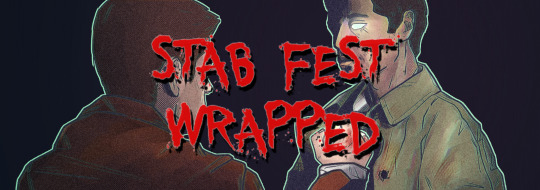
GREETINGS, STABBERS
Last year was the debut of our precious child, DeanCas StabFest (FUNSIZED), and in the very humble opinion of the mods, it was a smashing success! we promised to bring you guys some stats to explore how the fest went down.
NB: The data is skewed more towards the fic, rather than the art. we know this, and we are sorry. we love love LOVE all the artists, and want to explore all that metadata as well, but we also want to protect copyright. The metadata for the fic is accessible manually from AO3 (the mods have been toiling in the spreadsheet mines for weeks), or was provided to us by the participants via the masterpost form. However, getting more metadata on the art would require us to feed the full images into an analysis program, and we just can't trust that data won't be misused.
The art metadata that is present in this Wrapped was attained either by human eyeball, or by using Jasc Paint Shop Pro 7.02, which was released on March 5, 2001 and does not have online capabilities. It has plenty of other capabilities, okay. Do not underestimate the grampa software. There is a HOT WAX filter. Also it was paid for ONCE. none of that subscription crap. suck our dicks adobe
NB2: STABFEST WRAPPED is not about competition (except for competing to make StabFest 2023 even more unhinged than 2022.) We are not ranking the participants; we are lining everyone up to give them a smooch on the forehead. There will be a few individuals mentioned here and there, but every team has oodles and oodles of data that we've been crunching, and everyone was part of making DeanCas StabFest 2022 into this handsome, virile beast.
Missed the Fest, or want to refresh your memory? Check out the MASTERLIST:
Part One
Part Two
You can also check out the StabFest2022 collection on AO3.
Alright, let's go!
Pitcher, Catcher? Author, Artist?
DeanCas StabFest 2022 (Fun-sized!) had 33 teams: 27 in the regular bang and 6 in the reverse bang. 31 authors and 25 artists participated. Three people participated as both author and artist, leading to a total of 53 participants. One person was on multiple teams as an author and four people were on multiple teams as artists.
Author/Artist switch hitters: KaylieMalinza (teams 4, 10, 12, 27, 200, and 600), Maple (teams 28 and 15) and Swirlycloud (teams 16 and 20.)
Mega Author: MBQ (teams 13, 14, and 15)
Mega Artists: Biscuit_tin (teams 100, 21, and 13), Lauryn T. (teams 22 and 27) and Mortea (teams 19, 25, 500, and 700.)
(yes, the two participants who were on the most teams (5 and 4) are the mods, but this was a pinch hitter/oh god the reverse bang is too smol situation okay don't look at us like that this isn't like the scene in chocolat where the antagonist breaks into the candy shop and gorges on everything this was SACRIFICE for the SAKE OF THE FEST. also it was fun and the mods regret nothing.)
What It Says On The Tin
Of the 33 teams, 22 of them showed STAB in the artwork and 7 of them referenced STAB in the fic title. (this was interpreted fairly loosely--if the STAB was imminent or the aftermath was visible in the art, and if the title held any mention of stab, cut, slice, etc. we counted it as a yes.) Of the 26 fic which did not reference STAB in the title, 3 did reference the stabbing implement.
You Must Be This Tall To Ride
Of AO3's four ratings, the majority of the fic were rated Teen and Up, and the next most common rating was Mature. There was only one brave fic rated General Audiences--but that may have more to do with people rating higher than needed out of caution. No one wants a nastygram from a puriteen who thinks Disney is too risque and scary for children. Anyway--the MPAA doesn't give official ratings to fanfic. We go on vibes, and reader beware.

Yeah, I Figured That Much. What Are You?
Of the artwork, 22 of the entries were digital art, 10 were traditional/physical, and 1 piece appeared to be mixed physical and digital (we were guessing on traditional vs digital art and may have gotten it wrong sometimes! sorry.) A 1:2 ratio of traditional to digital was a very pleasant surprise.
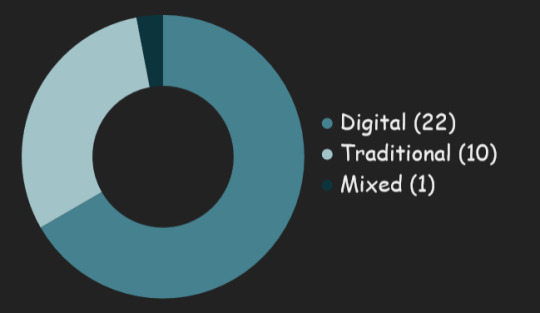
The STICKERS had a pretty good spread, too, with notable outliers being only 1 team receiving the Rebar of Shame and a whopping 18 teams receiving the Cannon of Canon Complicity. In total, 50 stickers were awarded. Special shout out to MBQ, who managed to qualify for every sticker across their three entries. The Rebar of Shame would have been so lonely without you.
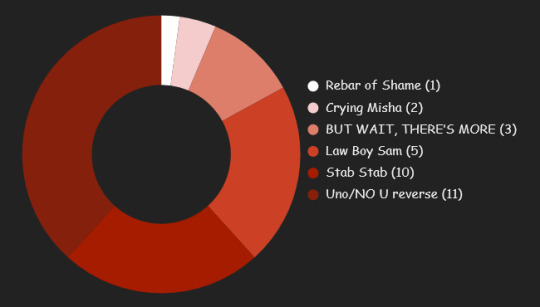
Weapon of Choice
Speaking of rebar, there was a tasty variety in the stabbing implements used. 8 teams had multiple implements, leading to a total of 41 implements. Far and away the most used implement was a knife--5 instances of the OG demon knife, and an additional 14 knives of various types--cooking, hunting, ka-bar, etc. , for a total of 19. The runner up was the angel blade, clocking in at 5 instances, with arrow and sword coming in behind at 3 and 2 instances, respectively. The most exciting implements, however, are those which were unique, only one instance each.
Of all the implements, we estimate that 34 of them were used for their intended purpose--needle, syringe, and scalpel, for example--with 8 very special implements being employed "off label."
We can beat those numbers this year, team!
Let's make 2023 StabFest off label AF.

According to the Lore
Of the AO3 tags, it should come as no surprise that there were 33 iterations of STAB, and 30 iterations of Castiel/Dean Winchester (tabulated separately from Castiel & Dean Winchester--some fic were tagged with both.) The Sam Winchester character tag also showed up 19 times (not including variants such as "Injured Sam Winchester," pairing tags, or, a mod favorite, "pray for sammy.") Canon made an appearance in 22 tags--including Canon-Typical Violence as well as Canon Elements, Canon Compliant, etc. Angst and Blood showed up in 11 and 12 tags, respectively.
A few more tags were cherry picked for the chart below; including every tag would be very difficult, since the 33 fic were tagged with a staggering total of 372 unique tags.
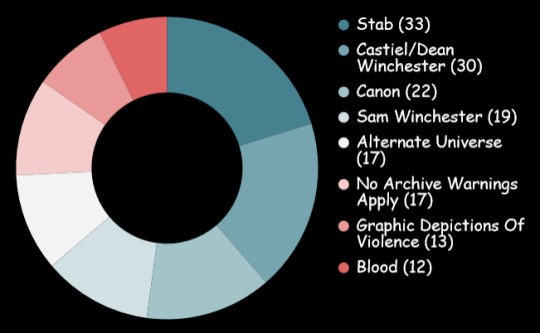
The mods would like to give a special shout out to the freeform tags. They were delightful in situ and tantalizing out of context. Here are our top ten favorites, in no particular order:
a frankly concerning number of references to Leonard Cohen's Hallelujah (All That Remains, by DoctorProfessorSong)
author was craving s'mores while writing this (Hunger Pains, by Followsthebees)
copious use of frog analogies?? (apologue of the boiling frog, by howldean)
dean is re-hymenated and as smooth as a baby's bottom (Rescue Burrito, by KaylieMalinza)
But Dean Forgives Him Because He's Smitten (Just Like Knitting, by FriendofCarlotta)
cas has a metaphorical c-section in here and that’s all you need to know (Fill Thyself with the Word of God, by themauvesoul)
Sam and Cas come up with a crazy idea and Dean counts to ten in the background. (The Good Old College Try, by silver_penny)
Cas triggers his own trauma by jerking off to the wrong thing (eros and thanatos, by autisticandroids)
oh well it's Cas what would you expect?! (Dusk When I Met You, by MiracleofWinchester)
There is also taco salad somewhere (Happy Kitty, by MBQ)
The mods also, with glimmering eyes and trembling hands, present a gold star to the tag that Understood The Assignment:
Apologies for attempted murder doubling as intricate rituals also (By your hand, by SlopeSlippers)
Thanks, buddy. StabFest feels Seen.
My True Form is Approximately The Size of Your Chrysler Building
As StabFest is FUN-SIZED, it should come as no surprise that most of the fic had fairly low word counts. With a required minimum of 1,500, 5 fic were between 1,500 and 2,500 words, and 8 were between 2,500 and 3,500. With a grand total word count of 183,643 spread across 33 fic, the average word count is 5,464--but since the median was only 4,397, then clearly the three fic with word counts over 15,400 were outliers adn should not have been counted.
The stab-free zone between 10k and 15k requires further study. 🧐
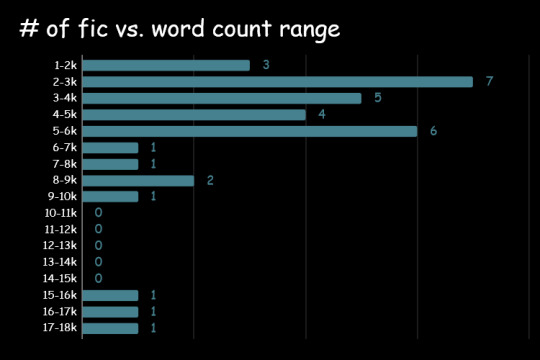
The art sizes had no measurable minimum--the rules just stated one art piece minimum, with no details about dimensions, resolution, etc. Some curious numbers shook out, though.
The width of the pieces ranged from 500 to 2048 pixels, with a median of 1280. The height ranged from 386 to 4716, with a median of 1280. (NB: some artists did multiple pieces for a single team, such as a main art piece and a banner, or multiple main art pieces. E.g., that 4,716 comes from three pieces of 1572 pixel height being combined.) In total, the StabFest art from all 33 teams is 36,433 pixels wide by 41,378 pixels tall. Perhaps some enterprising soul can convert that to football fields.

File size, as reported by Windows Explorer, ranged from 49.1kB to 4670kB with a median of 638.5kB. Bear in mind that some of these pieces would have been resized by tumblr or another hosting service, and of course, multiple pieces for the same team are added together. The total size, based on the files currently available, is 25630.08kB, or 25.63MB.
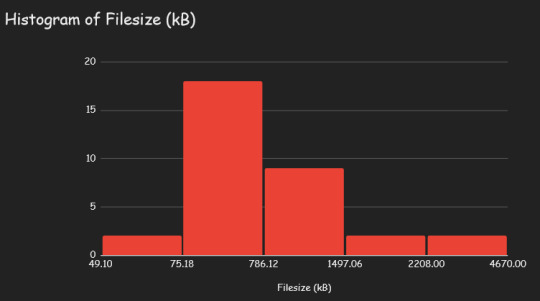
Certain People, Special People, Can Perceive My True Visage
What's most fun is the little option is Jasc Paint Shop Pro 7.02 to show the number of unique colors. These ranged from a minimum of 11,323 (The art for Forest Fever) to a maximum of 894,465 (the art for Light Me Up With Your Ardent Sword--hi res versions available on AO3), with a median of 95,293. You'd think the sum of the unique colors would be HUGE--and yes, if you add up all the numbers you get a whopping 4,616,209--but of course there's going to be a lot of overlap.
After combining all the StabFest art into a single MEGAZORD, like the Power Rangers, we see that the number of unique colors is much smaller: 2,272,549. That means there are 2,343,660 colors which are shared by at least two entries. Isn't that sweet? It's like the art is holding hands.

Because The Mods Commanded It. Because We Have Work for You.
Well, that wraps up StabFest2022 Wrapped. If you had fun last year and want to see what StabFest Wrapped2023 will look like, please check out the new features (femslash!! new stickers! A DISCORD) and mosey on over to the sign up form. And please take a gander at our promo post tag and see if something catches your fancy for a signal boost.
43 notes
·
View notes
Text
job opportunities in chennai for freshers - Career.contact
Job Opportunities in Chennai for Freshers
Finishing college and stepping into the job market is a big milestone. It’s exciting, confusing, and sometimes overwhelming. One of the first big decisions is choosing where to start your career. If you’re considering Chennai, you’re already heading in a smart direction.
Chennai is among India's most vibrant cities in terms of job prospects. It has a robust industry complemented by an emerging technology and services economy. For newcomers, that translates to choices — many of them — cutting across industries and job types.

A Strong Tech and IT Presence
When one hears about jobs in Chennai, IT is the first thing that comes to mind. And rightly so. The city has some of the big IT parks, particularly along OMR and Guindy. Freshers with a computer science, information technology, or even electronics and communication background can get jobs in software development, testing, support, and so on.
Startups are also gaining momentum, so you can even venture into product-based firms that seek young minds with fresh ideas.
Core Engineering Jobs
If you belong to a mechanical, civil, or electrical background, Chennai has something concrete to offer. Dubbed the "Detroit of India," it's a hub for the automobile and manufacturing sector. Several plants, both local and multinational, have units in and around the city.
Freshers can apply for entry-level positions in design, production, maintenance, and quality control. These positions tend to provide hands-on experience, which can be a major advantage early in your career.
BPO and Customer Support Positions
Chennai is also well-represented in the BPO and customer service industries. These careers are available to graduates with backgrounds in a broad spectrum of schools — and to many, they're the bridge to the corporate world.
They get you used to hard work, verbal communication, and timely work — all essential no matter what career path you later end up in.
Finance, Admin & Operations
Commerce and business graduates will find many opportunities in Chennai’s finance and corporate services sector. Banks, consultancies, and backend offices of large firms are always on the lookout for fresh talent to fill roles in accounting, data processing, admin support, and more.
These positions can serve as the groundwork for building a career in finance, business analysis, or management over time.
Media, Content, and Digital Careers
The creative ecosystem in Chennai has been steadily developing over the past couple of years. Digital marketing agencies, content studios, YouTube channels, and design companies are always on the lookout for new content creators, social media managers, video editors, and graphic designers.
If you're a fresher with good creative skills, a good portfolio, or even just an active blog or Instagram account — you may already possess what it takes to begin.
Education and EdTech
With its high-learning environment, Chennai is also an ideal location to begin a career in teaching or education services. EdTech websites, schools, and training schools recruit freshers as tutors, content writers, coordinators, or counselors.
If you are interested in teaching or student services, this is an area worth pursuing — given the success of online learning.
Conclusion
Beginning a career is seldom easy, but the right city can ease the process. Chennai has plenty of job opportunities for freshers — whether you're an engineering graduate, a business school graduate, or a creative mind.
The city boasts a friendly work environment, a comparatively lower living cost than other metros, and a combination of old and new industries. Your initial job may not be ideal — and that's alright. What counts is to start, and learn as much as you can on your way up.
If you remain open, flexible, and willing to learn, Chennai can prove to be a wonderful place to establish the building blocks of a successful career.
3 notes
·
View notes
Text
C++ Programming Language – A Detailed Overview
C++ is a effective, high-overall performance programming language advanced as an extension of the C language. Created via Bjarne Stroustrup at Bell Labs in the early Eighties, C++ delivered object-orientated features to the procedural shape of C, making it appropriate for large-scale software program development. Over the years, it has emerge as a extensively used language for machine/software program improvement, game programming, embedded systems, real-time simulations, and extra.
C ++ Online Compliers
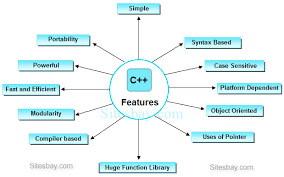
C++ combines the efficiency and manage of C with functions like classes, items, inheritance, and polymorphism, permitting builders to construct complex, scalable programs.
2. Key Features of C++
Object-Oriented: C++ supports object-orientated programming (OOP), which include encapsulation, inheritance, and polymorphism.
Compiled Language: Programs are compiled to machine code for overall performance and portability.
Platform Independent (with Compiler Support): Though not inherently platform-unbiased, C++ programs can run on a couple of structures when compiled therefore.
Low-Level Manipulation: Like C, C++ permits direct reminiscence get right of entry to thru suggestions.
Standard Template Library (STL): C++ consists of powerful libraries for facts systems and algorithms.
Rich Functionality: Supports functions like feature overloading, operator overloading, templates, and exception dealing with.
3. Structure of a C++ Program
Here’s a primary C++ program:
cpp
Copy
Edit
#encompass <iostream>
the use of namespace std;
int important()
cout << "Hello, World!" << endl;
return zero;
Explanation:
#encompass <iostream> consists of the enter/output stream library.
Using namespace std; allows using standard capabilities like cout without prefixing std::.
Foremost() is the access point of every C++ program.
Cout prints textual content to the console.
Four. Data Types and Variables
C++ has both primitive and user-defined statistics types. Examples:
cpp
Copy
Edit
int a = 10;
glide b = 3.14;
char c = 'A';
bool isReady = true;
Modifiers like short, lengthy, signed, and unsigned extend the information sorts’ range.
5. Operators
C++ supports, !
Assignment Operators: =, +=, -=, and many others.
Increment/Decrement: ++, --
Bitwise Operators: &,
cout << "a is greater";
else
cout << "b is extra";
Switch Case:
cpp
Copy
Edit
transfer (desire)
case 1: cout << "One"; ruin;
case 2: cout << "Two"; smash;
default: cout << "Other";
Loops:
For Loop:
cpp
Copy
Edit
for (int i = zero; i < five; i++)
cout << i << " ";
While Loop:
cpp
Copy
Edit
int i = 0;
at the same time as (i < five)
cout << i << " ";
i++;
Do-While Loop:
cpp
Copy
Edit
int i = zero;
do
cout << i << " ";
i++;
whilst (i < 5);
7. Functions
Functions in C++ growth modularity and reusability.
Cpp
Copy
Edit
int upload(int a, int b)
go back a + b;
int major()
cout << upload(three, 4);
return 0;
Functions may be overloaded via defining multiple variations with special parameters.
Eight. Object-Oriented Programming (OOP)
OOP is a chief energy of C++. It makes use of instructions and objects to represent real-international entities.
Class and Object Example:
cpp
Copy
Edit
magnificence Car
public:
string logo;
int pace;
void display()
cout << brand << " velocity: " << pace << " km/h" << endl;
int main()
Car myCar;
myCar.Emblem = "Toyota";
myCar.Pace = 120;
myCar.Show();
go back zero;
9. OOP Principles
1. Encapsulation:
Binding facts and features into a unmarried unit (elegance) and proscribing get admission to the usage of private, public, or blanketed.
2. Inheritance:
Allows one magnificence to inherit properties from another.
Cpp
Copy
Edit
elegance Animal
public:
void talk() cout << "Animal sound" << endl;
;
class Dog : public Animal
public:
void bark() cout << "Dog barks" << endl;
; three. Polymorphism:
Same characteristic behaves in a different way primarily based at the item or input.
Function Overloading: Same feature name, special parameters.
Function Overriding: Redefining base magnificence method in derived magnificence.
Four. Abstraction:
Hiding complicated information and showing handiest vital capabilities the usage of training and interfaces (abstract training).
10. Constructors and Destructors
Constructor: Special approach known as while an item is created.
Destructor: Called whilst an item is destroyed.
Cpp
Copy
Edit
magnificence Demo
public:
Demo()
cout << "Constructor calledn";
~Demo()
cout << "Destructor calledn";
;
11. Pointers and Dynamic Memory
C++ supports tips like C, and dynamic memory with new and delete.
Cpp
Copy
Edit
int* ptr = new int; // allocate reminiscence
*ptr = 5;
delete ptr; // deallocate memory
12. Arrays and Strings
cpp
Copy
Edit
int nums[5] = 1, 2, three, 4, 5;
cout << nums[2]; // prints 3
string name = "Alice";
cout << call.Period();
C++ also supports STL boxes like vector, map, set, and many others.
Thirteen. Standard Template Library (STL)
STL offers established training and features:
cpp
Copy
Edit
#consist of <vector>
#consist of <iostream>
using namespace std;
int important()
vector<int> v = 1, 2, 3;
v.Push_back(four);
for (int i : v)
cout << i << " ";
STL includes:
Containers: vector, list, set, map
Algorithms: sort, discover, rely
Iterators: for traversing containers
14. Exception Handling
cpp
Copy
Edit
attempt
int a = 10, b = 0;
if (b == zero) throw "Division by means of 0!";
cout << a / b;
seize (const char* msg)
cout << "Error: " << msg;
Use attempt, capture, and throw for managing runtime errors.
15. File Handling
cpp
Copy
Edit
#consist of <fstream>
ofstream out("information.Txt");
out << "Hello File";
out.Near();
ifstream in("records.Txt");
string line;
getline(in, line);
cout << line;
in.Near();
File I/O is achieved the usage of ifstream, ofstream, and fstream.
16. Applications of C++
Game Development: Unreal Engine is primarily based on C++.
System Software: Operating systems, compilers.
GUI Applications: Desktop software (e.G., Adobe merchandise).
Embedded Systems: Hardware-level applications.
Banking and Finance Software: High-speed buying and selling systems.
Real-Time Systems: Simulations, robotics, and so on.
17. Advantages of C++
Fast and efficient
Wide range of libraries
Suitable for each high-level and low-level programming
Strong item-orientated aid
Multi-paradigm: procedural + object-oriented
18. Limitations of C++
Manual reminiscence management can lead to mistakes
Lacks contemporary protection functions (in contrast to Java or Python)
Steeper studying curve for beginners
No built-in rubbish series
19. Modern C++ (C++11/14/17/20/23)
Modern C++ variations introduced capabilities like:
Smart recommendations (shared_ptr, unique_ptr)
Lambda expressions
Range-based totally for loops
car kind deduction
Multithreading support
Example:
cpp
Copy
Edit
vector<int> v = 1, 2, three;
for (auto x : v)
cout << x << " ";
C++ is a effective, high-overall performance programming language advanced as an extension of the C language. Created via Bjarne Stroustrup at Bell Labs in the early Eighties, C++ delivered object-orientated features to the procedural shape of C, making it appropriate for large-scale software program development. Over the years, it has emerge as a extensively used language for machine/software program improvement, game programming, embedded systems, real-time simulations, and extra.
C ++ Online Compliers
C++ combines the efficiency and manage of C with functions like classes, items, inheritance, and polymorphism, permitting builders to construct complex, scalable programs.
2. Key Features of C++
Object-Oriented: C++ supports object-orientated programming (OOP), which include encapsulation, inheritance, and polymorphism.
Compiled Language: Programs are compiled to machine code for overall performance and portability.
Platform Independent (with Compiler Support): Though not inherently platform-unbiased, C++ programs can run on a couple of structures when compiled therefore.
Low-Level Manipulation: Like C, C++ permits direct reminiscence get right of entry to thru suggestions.
Standard Template Library (STL): C++ consists of powerful libraries for facts systems and algorithms.
Rich Functionality: Supports functions like feature overloading, operator overloading, templates, and exception dealing with.
3. Structure of a C++ Program
Here’s a primary C++ program:
cpp
Copy
Edit
#encompass <iostream>
the use of namespace std;
int important()
cout << "Hello, World!" << endl;
return zero;
Explanation:
#encompass <iostream> consists of the enter/output stream library.
Using namespace std; allows using standard capabilities like cout without prefixing std::.
Foremost() is the access point of every C++ program.
Cout prints textual content to the console.
Four. Data Types and Variables
C++ has both primitive and user-defined statistics types. Examples:
cpp
Copy
Edit
int a = 10;
glide b = 3.14;
char c = 'A';
bool isReady = true;
Modifiers like short, lengthy, signed, and unsigned extend the information sorts’ range.
5. Operators
C++ supports, !
Assignment Operators: =, +=, -=, and many others.
Increment/Decrement: ++, --
Bitwise Operators: &,
cout << "a is greater";
else
cout << "b is extra";
Switch Case:
cpp
Copy
Edit
transfer (desire)
case 1: cout << "One"; ruin;
case 2: cout << "Two"; smash;
default: cout << "Other";
Loops:
For Loop:
cpp
Copy
Edit
for (int i = zero; i < five; i++)
cout << i << " ";
While Loop:
cpp
Copy
Edit
int i = 0;
at the same time as (i < five)
cout << i << " ";
i++;
Do-While Loop:
cpp
Copy
Edit
int i = zero;
do
cout << i << " ";
i++;
whilst (i < 5);
7. Functions
Functions in C++ growth modularity and reusability.
Cpp
Copy
Edit
int upload(int a, int b)
go back a + b;
int major()
cout << upload(three, 4);
return 0;
Functions may be overloaded via defining multiple variations with special parameters.
Eight. Object-Oriented Programming (OOP)
OOP is a chief energy of C++. It makes use of instructions and objects to represent real-international entities.
Class and Object Example:
cpp
Copy
Edit
magnificence Car
public:
string logo;
int pace;
void display()
cout << brand << " velocity: " << pace << " km/h" << endl;
int main()
Car myCar;
myCar.Emblem = "Toyota";
myCar.Pace = 120;
myCar.Show();
go back zero;
9. OOP Principles
1. Encapsulation:
Binding facts and features into a unmarried unit (elegance) and proscribing get admission to the usage of private, public, or blanketed.
2. Inheritance:
Allows one magnificence to inherit properties from another.
Cpp
Copy
Edit
elegance Animal
public:
void talk() cout << "Animal sound" << endl;
;
class Dog : public Animal
public:
void bark() cout << "Dog barks" << endl;
; three. Polymorphism:
Same characteristic behaves in a different way primarily based at the item or input.
Function Overloading: Same feature name, special parameters.
Function Overriding: Redefining base magnificence method in derived magnificence.
Four. Abstraction:
Hiding complicated information and showing handiest vital capabilities the usage of training and interfaces (abstract training).
10. Constructors and Destructors
Constructor: Special approach known as while an item is created.
Destructor: Called whilst an item is destroyed.
Cpp
Copy
Edit
magnificence Demo
public:
Demo()
cout << "Constructor calledn";
~Demo()
cout << "Destructor calledn";
;
11. Pointers and Dynamic Memory
C++ supports tips like C, and dynamic memory with new and delete.
Cpp
Copy
Edit
int* ptr = new int; // allocate reminiscence
*ptr = 5;
delete ptr; // deallocate memory
12. Arrays and Strings
cpp
Copy
Edit
int nums[5] = 1, 2, three, 4, 5;
cout << nums[2]; // prints 3
string name = "Alice";
cout << call.Period();
C++ also supports STL boxes like vector, map, set, and many others.
Thirteen. Standard Template Library (STL)
STL offers established training and features:
cpp
Copy
Edit
#consist of <vector>
#consist of <iostream>
using namespace std;
int important()
vector<int> v = 1, 2, 3;
v.Push_back(four);
for (int i : v)
cout << i << " ";
STL includes:
Containers: vector, list, set, map
Algorithms: sort, discover, rely
Iterators: for traversing containers
14. Exception Handling
cpp
Copy
Edit
attempt
int a = 10, b = 0;
if (b == zero) throw "Division by means of 0!";
cout << a / b;
seize (const char* msg)
cout << "Error: " << msg;
Use attempt, capture, and throw for managing runtime errors.
15. File Handling
cpp
Copy
Edit
#consist of <fstream>
ofstream out("information.Txt");
out << "Hello File";
out.Near();
ifstream in("records.Txt");
string line;
getline(in, line);
cout << line;
in.Near();
File I/O is achieved the usage of ifstream, ofstream, and fstream.
16. Applications of C++
Game Development: Unreal Engine is primarily based on C++.
System Software: Operating systems, compilers.
GUI Applications: Desktop software (e.G., Adobe merchandise).
Embedded Systems: Hardware-level applications.
Banking and Finance Software: High-speed buying and selling systems.
Real-Time Systems: Simulations, robotics, and so on.
17. Advantages of C++
Fast and efficient
Wide range of libraries
Suitable for each high-level and low-level programming
Strong item-orientated aid
Multi-paradigm: procedural + object-oriented
18. Limitations of C++
Manual reminiscence management can lead to mistakes
Lacks contemporary protection functions (in contrast to Java or Python)
Steeper studying curve for beginners
No built-in rubbish series
19. Modern C++ (C++11/14/17/20/23)
Modern C++ variations introduced capabilities like:
Smart recommendations (shared_ptr, unique_ptr)
Lambda expressions
Range-based totally for loops
car kind deduction
Multithreading support
Example:
cpp
Copy
Edit
vector<int> v = 1, 2, three;
for (auto x : v)
cout << x << " ";
C Lanugage Compliers
2 notes
·
View notes
Text
IoT Security Challenges in India: Protecting Smart Homes & Connected Devices

IoT is transforming the way people live by making their homes smart with devices such as security cameras, smart locks, and voice assistants. In India, IoT technology is adopted at a pace that cyber threats are rising rapidly. With weak security protocols, outdated software, and unawareness, Indian households are vulnerable to cyberattacks. In this blog, we will explore the major IoT security challenges in India and how individuals can safeguard their smart homes and connected devices. If you are looking to strengthen your understanding of cybersecurity, enrolling in a cyber security course can be a game-changer.
The IoT Boom in India
India is witnessing the highest adoption of IoT across homes and businesses. From smart TVs to intelligent thermostats, IoT is revolutionizing life. This booming technology, however, offers a large target size for hackers too who exploit the vulnerability of devices to gain unauthorized access to data.
Fundamental Drivers of IoT Adoption in India:
Increased internet penetration with low-priced data plans
Government initiatives such as Smart Cities Mission and Digital India
Increasing adoption of smart home devices as they become increasingly affordable
Growing application of industrial IoT in health, agriculture, and manufacturing
Chief IoT Security Challenges in India
Poor Authentication & Default Passwords
Most IoT devices have a factory-set password that the user ignores or fails to change. Hackers exploit these default credentials to take over the devices, entry private networks, and crack sensitive information.
Lack of Security Updates & Patches
Most smart devices have limited or no firmware updates, which makes them vulnerable to cyber threats. Many Indian consumers do not check for security updates, leaving their devices susceptible to known exploits.
Data Privacy Concerns
Smart devices collect vast amounts of personal data, from voice recordings to daily routines. Without stringent data protection policies, this information can be misused or leaked by malicious actors.
Botnet Attacks & DDoS Threats
Cybercriminals hijack unprotected IoT devices to form botnets, which are used to launch massive Distributed Denial of Service (DDoS) attacks. These attacks can cripple networks and cause disruptions to online services.
Unsecured Wi-Fi Networks
Many Indian households rely on poorly secured Wi-Fi connections, providing an easy entry point for hackers. Without encryption or strong passwords, attackers can intercept sensitive information and compromise connected devices.
Absence of Specific Cybersecurity Legislation for IoT
India has advanced in data protection with the Digital Personal Data Protection Act, but there is no dedicated IoT security framework. The absence of it leaves the manufacturer to choose cost over security and sell devices which are not so well protected in the market.
How to Secure Smart Homes & Connected Devices
Change Default Credentials
Always change the default usernames and passwords of the IoT after installation. Use strong, unique passwords and implement multi-factor authentication wherever possible.
Update Firmware Periodically
Scan for software and security updates on all smart devices, and install them as soon as they are available. In case your device can no longer get any updates, consider replacing it with a newer version that is at least as secure.
Secure Your Wi-Fi Network
Use a robust Wi-Fi password, and make sure WPA3 encryption is turned on. Limit remote access to your router, and make an IoT-specific network so that those devices can't contaminate your primary network.
Firewall & Security Solutions The use of firewalls and network security solutions monitors traffic and can block malicious activity on IoT networks. 5. Limit Data Sharing & Permissions
Assess permission for smart appliances and reduce or limit the devices from accessing unsecured personal information. De-activate unused add-ons, remote access in devices.
Cyber Security Courses
IoT-based cyber-attacks are minimized if awareness against the threat builds. To boost that awareness further, take time out to become a certified graduate of cyber security by signing for courses in areas like best security practices, principles of ethical hacking, and defending digital systems.
Road Ahead to Improving Indian IoT Security:
The Indian government, device manufacturers, and consumers must take proactive steps to mitigate IoT security risks. Stronger security standards, public awareness, and robust cybersecurity laws are the need of the hour to secure the future of IoT in India.
Conclusion
IoT devices offer incredible convenience but also introduce significant security risks. Protecting smart homes and connected devices requires a combination of best practices, awareness, and robust cybersecurity measures. By staying informed and adopting the right security strategies, individuals can ensure a safer IoT experience.
If you’re passionate about cybersecurity and want to build expertise in protecting digital systems, consider taking a cyber security course to gain hands-on knowledge and skills in ethical hacking, network security, and data protection.
3 notes
·
View notes
Text
Nonprofit Software: A Key to Efficient Mission Management
Nonprofit organizations operate in a challenging environment where maximizing impact is essential while keeping administrative costs low. Managing donations, volunteers, events, and operational workflows can be overwhelming without the right tools. Nonprofit software has emerged as a vital solution, tailored to address the specific needs of mission-driven organizations. These tools streamline operations, enhance donor engagement, and ultimately help nonprofits achieve their goals more effectively.
In this article, we’ll explore the types, benefits, and future of nonprofit software, shedding light on how it empowers organizations to thrive in today’s competitive landscape.
What is Nonprofit Software?
Nonprofit software refers to digital tools and platforms specifically designed to help nonprofits manage their operations efficiently. Unlike generic software, nonprofit-specific tools address core needs such as donor relationship management, fundraising, volunteer coordination, grant tracking, and financial reporting. With features tailored to their unique challenges, nonprofits can save time, optimize resources, and focus on their missions.
Types of Nonprofit Software
Donor Management Software Also known as nonprofit CRM (Customer Relationship Management), donor management software helps organizations track donor interactions, manage contributions, and personalize engagement. Tools like Bloomerang, DonorPerfect, and Little Green Light simplify donor retention and make campaigns more effective.
Fundraising Software Platforms like Classy, Givebutter, and Fundly empower nonprofits to create online fundraising campaigns, process donations, and analyze results. Peer-to-peer fundraising, recurring donations, and mobile giving features enhance the donor experience.
Volunteer Management Tools Managing volunteers is essential for many nonprofits. Tools like VolunteerHub and SignUpGenius streamline recruitment, scheduling, and communication, ensuring an organized and engaged volunteer base.
Grant Management Software Grant tracking tools such as Foundant or Submittable help nonprofits identify funding opportunities, submit applications, and manage deadlines and compliance, improving the chances of securing vital grants.
Accounting and Financial Management Software Nonprofits need tools to maintain transparency and manage budgets. Accounting software like QuickBooks for Nonprofits or Aplos ensures accurate reporting, proper fund allocation, and regulatory compliance.
Event Management Software Nonprofits often rely on events to engage supporters and raise funds. Tools like Eventbrite or Cvent simplify event planning, ticketing, and attendee management, creating seamless experiences for donors and participants.
Benefits of Nonprofit Software
Operational Efficiency Nonprofit software automates routine tasks such as data entry, reporting, and communication, allowing staff to focus on mission-critical activities.
Improved Donor Relationships With donor management tools, nonprofits can personalize outreach, track giving history, and maintain strong relationships that increase donor retention.
Transparency and Accountability Financial and grant management tools ensure that nonprofits comply with regulations and demonstrate transparency to stakeholders, boosting credibility.
Better Decision-Making Analytics and reporting features provide valuable insights into campaign performance, donor behavior, and operational efficiency, enabling data-driven decisions.
Scalability As nonprofits grow, software solutions can scale to accommodate larger donor bases, expanded programs, and increasing complexity.
Challenges of Implementing Nonprofit Software
While nonprofit software offers significant benefits, organizations may face challenges, including:
Budget Constraints: Even with nonprofit discounts, advanced tools can strain limited budgets.
Learning Curve: Staff and volunteers may require training to use the software effectively.
Integration Issues: Ensuring new tools work seamlessly with existing systems can be complex.
Data Security: Protecting sensitive donor and organizational data is crucial and requires robust security measures.
Organizations should evaluate their specific needs, select user-friendly tools, and partner with providers offering support and training to overcome these challenges.
Future of Nonprofit Software
The future of nonprofit software lies in innovation and technology integration. Artificial intelligence (AI) is already being used to predict donor behavior, optimize outreach, and analyze trends. Blockchain technology is enhancing transparency in donation tracking, while virtual reality (VR) is creating immersive experiences to engage donors. These advancements will further empower nonprofits to achieve their missions efficiently and effectively.
Conclusion
Nonprofit software is transforming the way mission-driven organizations operate. From donor management and fundraising to financial tracking and volunteer coordination, these tools address the unique challenges nonprofits face. By adopting the right software solutions, organizations can save time, optimize resources, and focus on what truly matters—making a difference in the world.
As technology continues to evolve, nonprofit software will remain a cornerstone of effective mission management, helping organizations thrive in a rapidly changing environment. For nonprofits seeking to maximize their impact, investing in the right software is not just an option—it’s a necessity.
3 notes
·
View notes
Text
I'd rather have been asleep at 1:40am instead of laying there thinking about how uncertain and scared I feel right now, but I was laying there feeling uncertain and scared and realized I have no idea what people that work in offices DO.
I've only worked retail/customer service outside of the military and even while working in an office in the military, I had nothing to do.
At first I was put in one office that didn't need me so they just said "Here... Manage these files." and I was like "..... how, exactly??" and ended up retyping the labels for all of them because some were wrong and there was nothing else for me to do.
Then they gave me the personnel database. I rebuilt it and made it accessible in two days, and that was it. After that, I filled out orders for one person once. The only way I had anything to DO was by becoming the mail clerk which is another customer-facing, cyclically repetitive task that is never done and needs redone in the same way every day. After the mail was done, which took about two hours, I would leave or go sit in my office with nothing to do because the database was my whole job and it was DONE. It wouldn't need changed until the software was updated and that wouldn't be for years.
I had a once-a-week task of making a physical copy of the server which meant going into a closet, popping a tape into a machine, and waiting. I had to sit there with it. There was nothing else to do. I got in trouble for coloring in a coloring book while waiting for the backups to write and I was like "........ What am I SUPPOSED to do, then?????" "Work on the database!" "It's DONE........"
If it's SQL stuff do people sit around until the boss says "Hey, I need to know how much we spent on avocado toast this month." and then whip up a report real quick and wait for the boss to want a report on something else? What about when the boss doesn't need a report?
What do IT people do when things are working smoothly?
I can understand data entry, that would be like "Here we have all these waivers that were signed for the indoor trampoline business and these need plugged into the database manually because the online one was down so they're on paper." or something like that but what about when the online waivers do work what do they do then?
?????
It's like that episode of Seinfeld where George gets an office job but just sits there all day because he has no idea what he's supposed to be doing, no one tells him, and he eventually gets fired because he didn't do anything.
13 notes
·
View notes
Text
AI & Tech-Related Jobs Anyone Could Do
Here’s a list of 40 jobs or tasks related to AI and technology that almost anyone could potentially do, especially with basic training or the right resources:
Data Labeling/Annotation
AI Model Training Assistant
Chatbot Content Writer
AI Testing Assistant
Basic Data Entry for AI Models
AI Customer Service Representative
Social Media Content Curation (using AI tools)
Voice Assistant Testing
AI-Generated Content Editor
Image Captioning for AI Models
Transcription Services for AI Audio
Survey Creation for AI Training
Review and Reporting of AI Output
Content Moderator for AI Systems
Training Data Curator
Video and Image Data Tagging
Personal Assistant for AI Research Teams
AI Platform Support (user-facing)
Keyword Research for AI Algorithms
Marketing Campaign Optimization (AI tools)
AI Chatbot Script Tester
Simple Data Cleansing Tasks
Assisting with AI User Experience Research
Uploading Training Data to Cloud Platforms
Data Backup and Organization for AI Projects
Online Survey Administration for AI Data
Virtual Assistant (AI-powered tools)
Basic App Testing for AI Features
Content Creation for AI-based Tools
AI-Generated Design Testing (web design, logos)
Product Review and Feedback for AI Products
Organizing AI Training Sessions for Users
Data Privacy and Compliance Assistant
AI-Powered E-commerce Support (product recommendations)
AI Algorithm Performance Monitoring (basic tasks)
AI Project Documentation Assistant
Simple Customer Feedback Analysis (AI tools)
Video Subtitling for AI Translation Systems
AI-Enhanced SEO Optimization
Basic Tech Support for AI Tools
These roles or tasks could be done with minimal technical expertise, though many would benefit from basic training in AI tools or specific software used in these jobs. Some tasks might also involve working with AI platforms that automate parts of the process, making it easier for non-experts to participate.
4 notes
·
View notes
Text
Auction Inventory Software: Elevating Efficiency in Auction Management
Auction inventory software revolutionizes how auction organizers manage, track, and catalog items. This technology brings efficiency to every stage of the auction process, from listing items to final sales. With real-time tracking and automated reporting features, inventory software simplifies operations for auction houses, online platforms, and private sellers, creating a seamless and well-organized experience for all involved.
Key Features and Advantages of Auction Inventory Software
Auction inventory software offers essential tools that streamline auction management, boost efficiency, and improve accuracy. Here’s a summary of its top features:
Streamlined Cataloging and ListingsEnables easy digital cataloging with photos and descriptions, allowing auctioneers to present organized, engaging listings that attract more bidders.
Real-Time TrackingProvides real-time monitoring of item locations and status, enhancing organization and transparency, and reducing risks of item misplacement.
Automated Valuation and PricingUses historical data and market insights to set competitive, data-driven prices, building bidder confidence and saving time.
Integrated Bidding PlatformConnects item listings to live or timed bidding, creating a unified platform for bidding, which simplifies management and ensures accurate tracking.
Reporting and AnalyticsDelivers insights on bidding patterns, item popularity, and performance, empowering auction organizers to refine strategies for future success.
Auctions That Benefit from Inventory Software
Inventory software’s flexibility makes it suitable for various types of auctions, from traditional to online formats. Here are some types that benefit most:
Estate and Personal Property: Perfect for managing and cataloging a wide range of items.
Fine Art and Collectibles: Supports detailed descriptions and high-quality images, ideal for unique or high-value pieces.
Real Estate Auctions: Simplifies tracking of properties and supports regulatory compliance with accurate record-keeping.
Vehicle Auctions: Tracks different types of vehicles with tools for valuation and condition reports.
Enhancing Efficiency with Auction Inventory Software
Auction inventory software boosts efficiency by centralizing data, minimizing manual entry, and enabling quick adjustments. With real-time updates and easy access to information, teams can work faster and make informed decisions, improving the overall participant experience.
The software securely stores records, facilitating compliance and ensuring that auction teams maintain audit-ready data for future planning. Streamlining access to auction details, it helps keep operations organized, allowing teams to focus on delivering engaging experiences while safeguarding essential auction data.
The Future of Auction Inventory Software
As technology advances, auction software is expected to incorporate even more features. Artificial intelligence could enhance item appraisals, while blockchain technology might improve transparency and security in tracking. Augmented reality could provide a more interactive experience, allowing bidders to view items virtually before making bids. As these advancements become available, auction inventory software will continue to evolve, offering even more value to auction organizers.
Conclusion
Auction inventory software reshapes the auction experience with streamlined cataloging, tracking, and data analysis features. By reducing manual work and enhancing organization, this software supports more efficient auctions and delivers a better experience for bidders. For auction organizers looking to improve efficiency, engage bidders, and achieve optimal results, integrating live auction software with inventory management systems is an invaluable asset. As the auction industry grows and modernizes, inventory software will remain essential, raising standards for service and auction outcomes.
2 notes
·
View notes
Text
CompTIA Certifications: Your Gateway to IT Success

Introduction
In today's technology-driven world, IT professionals play a crucial role in driving innovation and business growth. To validate their skills and stand out in the competitive job market, many individuals seek industry-recognized certifications. CompTIA certifications have emerged as a popular choice, offering a comprehensive pathway to IT success.
What are CompTIA Certifications?
CompTIA, the Computing Technology Industry Association, is a non-profit trade association that develops and delivers vendor-neutral IT certifications. These certifications are designed to assess an individual's knowledge and skills in various IT domains, including networking, cybersecurity, and cloud computing.
Benefits of CompTIA Certifications
Enhanced Career Prospects: CompTIA certifications are highly valued by employers worldwide. Earning a CompTIA certification can significantly boost your job prospects and open doors to new opportunities.
Increased Earning Potential: Certified IT professionals often command higher salaries compared to their non-certified counterparts. CompTIA certifications can directly contribute to your financial growth.
Industry Recognition: CompTIA certifications are recognized and respected throughout the IT industry. They serve as a testament to your expertise and professionalism.
Skill Development: Preparing for and passing a CompTIA certification requires a deep understanding of the relevant IT concepts and technologies. This process helps you develop valuable skills that can be applied in your daily work.
Vendor Neutrality: Unlike vendor-specific certifications, CompTIA certifications are vendor-neutral. This means they are not tied to a particular product or technology, making them more versatile and adaptable to various IT environments.
Popular CompTIA Certifications
CompTIA A+: This entry-level certification is ideal for IT professionals who want to build a solid foundation in computer hardware and software.
CompTIA Network+: This certification validates your knowledge of networking fundamentals, including network infrastructure, protocols, and troubleshooting.
CompTIA Security+: This certification focuses on cybersecurity and equips you with the skills to protect systems and data from threats.
CompTIA PenTest+: This certification validates your skills in penetration testing, a crucial aspect of cybersecurity.
CompTIA Data+: This certification focuses on data analysis and validates your ability to collect, analyze, and interpret data.
How to Prepare for a CompTIA Certification
Identify Your Goals: Determine which CompTIA certification aligns with your career aspirations and current skill level.
Choose Study Materials: Select high-quality study materials, such as textbooks, practice exams, and online courses.
Create a Study Plan: Develop a structured study plan that covers all the exam objectives.
Practice Regularly: Take advantage of practice exams to assess your knowledge and identify areas for improvement.
Join Study Groups: Connect with other candidates to share knowledge and motivation.
Opting certification courses: Enroll the CompTIA courses from Xaltius Academy.
Conclusion
CompTIA certifications offer a valuable pathway to IT success. By earning a CompTIA certification, you can enhance your career prospects, increase your earning potential, and gain recognition as a skilled IT professional. If you're looking to advance your IT career, consider pursuing a CompTIA certification.
2 notes
·
View notes
Text
Are you looking for a flexible work-from-home opportunity? Data entry jobs could be the perfect fit for you! These roles are ideal for individuals who are detail-oriented and organized, offering the chance to earn a steady income without the daily commute.
Why Choose Data Entry?
Flexibility: Work from the comfort of your home and set your own hours.
Skill Development: Enhance your typing, data management, and organizational skills.
Diverse Opportunities: Data entry jobs are available in various industries, providing a range of experiences.
What You Need
Basic computer skills and familiarity with software like Microsoft Excel.
A reliable internet connection.
Strong attention to detail and the ability to work independently.
How to Get Started
If you’re ready to dive into the world of data entry, applying online is easy! Check out the link below to find available positions and submit your application:
Apply..https://shorturl.at/leynM
Start your journey towards a flexible career today! Whether you’re looking for a side hustle or a full-time position, data entry could be your gateway to new opportunities. Don't wait—take the first step now
2 notes
·
View notes
Text
Mapping LGBTQ+ Spaces through the Years
by Chloe Foor, Student Historian 2022/2024
Hello everyone! Welcome to a little project update from your local Student Historian in Residence. The last two months have been filled with research, data collection, and learning new software programs. I’ve had a great time, and I can’t wait to share what I’ve been doing.
I spent the first few weeks of October doing more research, scouring both the Archives and the Internet to find more locations significant to LGBTQ+ Madisonians over the years. While in the Archives, I looked at the Lesbian, Gay, Bisexual, and Transgender (LGBT) Folder 1 Subject File, which has materials from the 1990s to the mid-2010s (see University of Wisconsin-Madison Subject Files collection. uac69, Box 75, Folder 10. University of Wisconsin-Madison Archives, Madison, WI.). The most interesting things to me was a document written by Joe Elder on Reflection on the LGBTQ movement on Campus, which he wrote in the aftermath of the 2016 Orlando Nightclub Shooting. It provided some really interesting perspectives on the LGBTQ+ Rights movement in Madison.
Online, my main source of information is the Wisconsin LGBTQ+ History Project, which I wrote more about in my last blog post. I didn’t realize that they had digitized copies of old guides that listed LGBTQ+ friendly businesses as far back as 1963. It was fascinating to go through those and find the locations that queer people frequented in the past. The most interesting place that I found that was listed was called Apple Island, which I have seen before in archival research, but I didn't know it was in Madison. Apple Island was a community organization created to promote women's culture, and it was reported that 90% of the clientele were lesbians. My favorite part of the research project is finding these lesser-known spaces, and I can’t wait for more people to be able to easily access them through my project!
Outside of finding new “spaces,” I spent some time filling in the spreadsheet I use to keep track of each location. For each space, I list the title, address, significance, and years it was active, but sometimes it's hard to find all of that information on the first pass through. Sometimes, I'll just write the title and a short description, and then I can go back through later and fill in the rest. Now, all 165 entries are fully fleshed out!

With the spreadsheet being fully populated, I was ready to import it into ArcGIS, a digital mapping software. It was able to read the spreadsheet into different categories and add every space to a map! In the above image, all of the gray makers are for “Purge,” the blue markers are for “Community,” the orange markers are for “Commercial Area,” the purple markers are for “Healthcare,” the pink markers are for “Media,” the green markers are for “Politics,” and the red markers are for “UW”! If you click on a marker, a pop-up window will display with information about the location, including beginning and end dates as well as a short description.
Here is the pop-up for The Crossing:
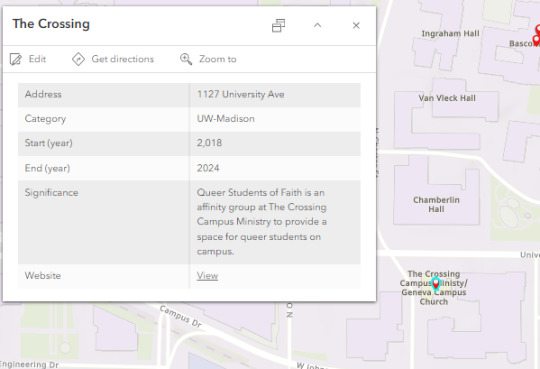
In the coming months, I will be working on making a public website to share my research! I also want to host an outreach event in collaboration with the Gender and Sexuality Campus Center and Phi Alpha Theta, the History Honors Society. I’m sure more meetings on the topic will come up in the coming months, and I will make sure to keep you posted! For now, though, that’s all from me!
7 notes
·
View notes